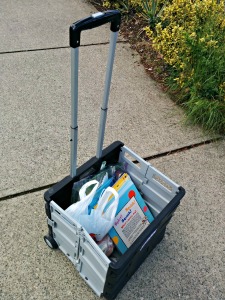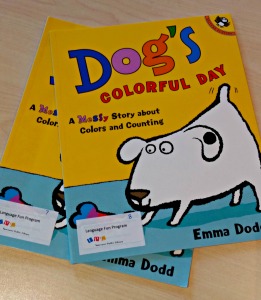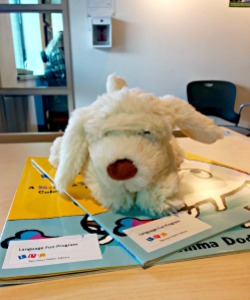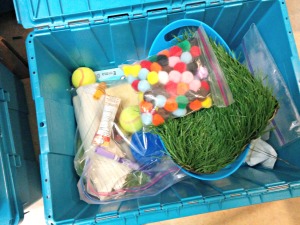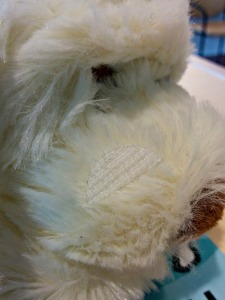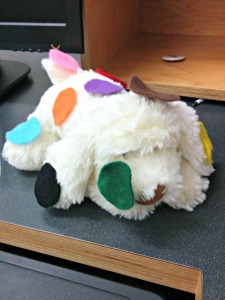
It was a lovely morning for a walk to the community health center for today’s LFST. For a children’s librarian a little fold-up trolley is a well used and well loved piece of equipment!
Today we shared a picture book that ticks all sorts of early literacy boxes – colors, numbers, sequencing, even parts of the body: Dog’s Colorful Day by Emma Dodd.
This lovely story builds nicely on the framework we set in a previous week’s program with Pete the Cat, and introduces additional colors and numbers. We have a few vocal dog lovers in the group as well, who were thrilled when we pulled out today’s story!
The highlight of today’s program was our furry little friend, Dog.
Because Dog’s Colorful Day is quite a long picture book for our group, and requires that the children sit and listen for an extended period of time, we decided to forgo the felt story component this week. Typically we use a picture book, a felt story, and a collection of toys and items to retell each story three times, but we wanted to make sure that every child had enough time to participate in the retelling, and didn’t want to have to rush anything, or anyone! Our children need a slower pace in order to get the most out of the program, which sometimes means adapting and altering our program.
While all the LFST kits are wonderful, this kit is particularly special, as it includes so many toys and items for the children to interact with and use to retell the story. There’s a chocolate bar, a purple marker, a little pot of dried-up blue paint, and more – check out that awesome bucket for giving Dog a bath at the end of the story, and that great chunk of astro-turf representing the green grass!
The little stuffed dog is pretty special too – he actually has little pieces of velcro attached to his fur.
The children use these velcro pieces to attached different pieces of coloured felt representing the different spots.
After reading the picture book we faithfully retold the story using the toys and felt spots, then played a game in which the children placed colours of their choice all over the dog. This gave the kids opportunities to practice colour and body part vocabulary and prepositions, as well as practice asking for things and expressing opinions.
For example, each child was asked, “which colour of spot do you want?” The child used his or her vocabulary to ask for a specific colour or indicate a preference, and was then asked where on the dog’s body they wanted to put the coloured spot. Children were encouraged to say “on his ear” or “on his tail”, with as much vocabulary and accuracy as was individually appropriate. The children delighted in putting coloured spots on dog’s nose or his tail, and we played this game several times to ensure that each child got a chance to participate. Even our more reticent children were more easily enticed this week. After all, who could resist this cuddly face?
It’s amazing to see the development in each child as they progress throughout the program – we have a number of children who were so shy at the beginning that they could barely whisper their names, but who are now enthusiastically shouting out the names of the different colours. You can see that their confidence is growing in leaps and bounds, which is in turn helping them get the most benefit out of each session.
Even I couldn’t resist this fluffy little guy!
